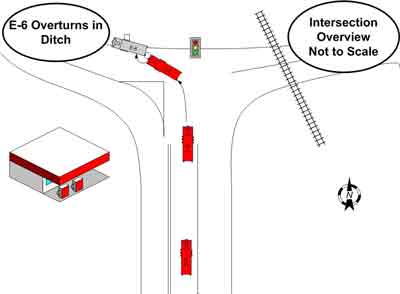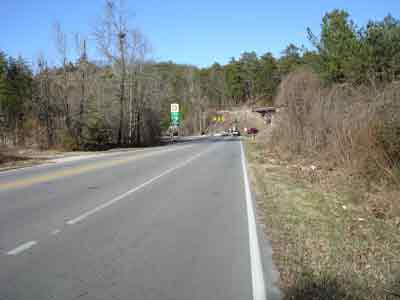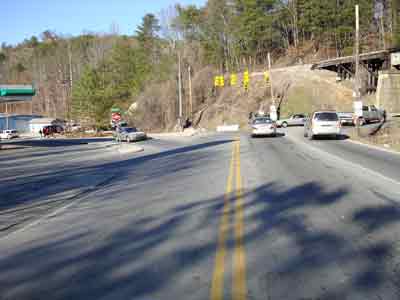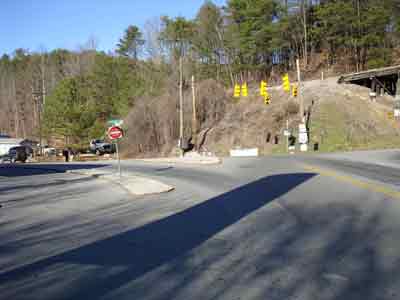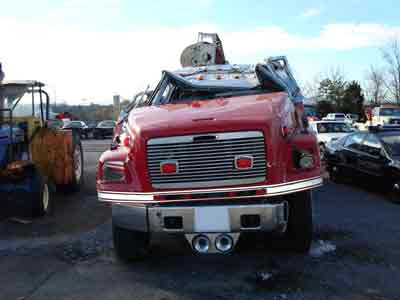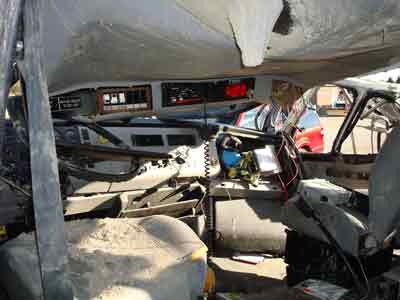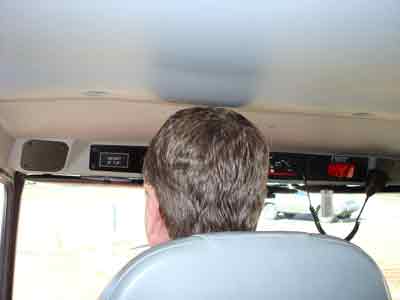One Career Fire Fighter Dies and Another is Seriously Injured in a Single Vehicle Rollover Crash - Georgia
 Death in the Line of Duty…A summary of a NIOSH fire fighter fatality investigation
Death in the Line of Duty…A summary of a NIOSH fire fighter fatality investigation
F2009-04 Date Released: August 10, 2009
SUMMARY
On December 31, 2008, a 24-year-old male career fire fighter (the victim) was fatally injured and another fire fighter (officer) was seriously injured after the victim lost control of the fire truck he was driving, struck a utility pole, and overturned in a ditch. The fire truck, with a crew of three fire fighters, was responding to a reported chimney fire when the single-vehicle crash occurred. The crash occurred as the fire truck was traveling through an intersection with pavement grade changes occurring at the intersection. Georgia state police investigators determined that the fire truck was traveling too fast for current road conditions. The victim was pinned between the driver’s seat and the roof of the apparatus, upside down with his seat belt fastened. The officer, who was seriously injured in the crash, was not wearing a seat belt and was briefly trapped. The officer and third crew member (fire fighter riding in the jump seat) initially tried to assist the victim before the arrival of other rescuers. The victim and the officer were transported to a local hospital where the victim was pronounced dead.
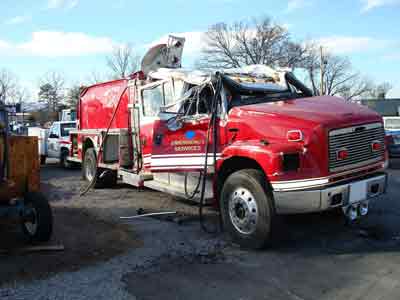 |
|
Apparatus involved in incident |
Key contributing factors identified in this investigation include: driving too fast for conditions, removing seat belts while the vehicle is in motion, insufficient training on intersections and difficult road conditions, driver inexperience with this specific apparatus, and lack of rollover protection.
NIOSH investigators concluded that, to minimize the risk of similar occurrences, fire departments should:
- ensure that fire fighters and officers are trained in maintaining safe control of responding fire apparatus
- ensure that SOPs on seat belt use are enforced
- provide training to driver/operators as often as necessary to meet the requirements of NFPA 1451, 1500, and 1002, with specific training on intersections and difficult road conditions
- ensure that drivers have experience in the class of vehicle they are expected to operate
- consider rollover protection for the crew areas of fire apparatus when upgrading or purchasing new apparatus
Fire apparatus manufacturers, researchers, and standard setting bodies should
- continue to improve fire truck safety standards and designs for increased crashworthiness
Additionally, federal and state departments of transportation should
- consider modifying or removing exemptions that allow fire fighters to not wear seat belts
INTRODUCTION
On December 31, 2008, at approximately 2245 hours, a 24-year-old male career fire fighter (the victim) was fatally injured and another fire fighter (the officer) was seriously injured after the victim lost control of the fire truck he was driving through an intersection and overturned in a ditch. On January 2, 2009, the U. S. Fire Administration (USFA) notified the National Institute for Occupational Safety and Health (NIOSH) of this fatality. On January 20-23, 2009, a safety and occupational health specialist from the NIOSH Fire Fighter Fatality Investigation and Prevention Program and two personnel from the Surveillance and Field Investigations Branch traveled to Georgia to investigate the incident. Photographs were taken of the incident scene and the involved fire apparatus. The NIOSH investigator met with representatives from the local fire department, Georgia state patrol, local sheriff’s office, fire fighters and officers from other local fire departments, emergency medical service (EMS) employees, and representatives from the county maintenance facility. Interviews were conducted with the fire chief, fire department officers, fire fighters, witnesses, the supervisor of the county maintenance facility, and the investigating officer from the Georgia State Patrol. NIOSH personnel reviewed the department’s standard operating procedures (SOPs), the victim’s training records, prior response records for the shift, and police photographs of the incident scene. NIOSH personnel were accompanied by a fire department representative to inspect the involved fire apparatus at a secured impound yard and to examine the incident scene. The NIOSH investigator also contacted the manufacturer of the fire apparatus and requested information on the truck’s original specifications. Information regarding the truck’s original drive train was obtained from the manufacturer’s line set ticketa and vehicle identification number.
a A line set ticket is a list-style document that details every part, and its specifications, that was added to a vehicle while it was on the assembly line. A dealership’s parts department can order a line set ticket from the vehicle identification number.
FIRE DEPARTMENT
The combination fire and rescue department involved in this incident employs 76 career fire fighters and EMS personnel and 138 volunteer members. The department has 18 fire stations serving approximately 60,000 residents with a primary response geographical area of 460 square miles. The department responds to approximately 3,000 emergency incidents annually. The department operates a total of 99 vehicles including 24 engines, 4 tankers, and 2 ladder trucks.
The department has SOPs that require successful completion of the department’s fire apparatus operator program. The SOPs provide requirements for seat belt usage by drivers and all passengers, driver training, minimum requirements for the class of driver’s license to operate different vehicles, and procedures for relief drivers. The SOPs also provide requirements for a slowed or reduced response (slower speed even to the point of stopping) when responding emergency vehicles encounter slippery roads, inclement weather, poor visibility, heavy traffic, blind intersections, negative right-of-way intersections, and intersection hazards and whenever the driver and officer cannot account for all lanes of traffic. The SOPs require the driver of an emergency vehicle to bring the apparatus to a complete stop when encountering the following:
- Red or yellow traffic light
- Stop signs
- Stopped or slowed school bus with operating warning lights/sign
- Railroad tracks.
Apparatus
The apparatus involved in the incident was purchased new in 1998 as part of a fleet purchase of 15 pumpers from the manufacturer. The truck was a 1,250 gallon-per-minute pumper equipped with a 1,500-gallon water tank mounted on a 216-inch wheelbase and a four-door commercial chassis with a gross vehicle weight rating of 33,160 pounds. The 1,500-gallon (baffled) water tank was reported to be full at the time of the incident. The water in the full water tank would have weighed approximately 12,510 lbs. The truck was equipped with a 325-horsepower diesel engine and a 5-speed automatic transmission. The truck had two axles and air-actuated drum brakes on the front and rear wheels. It also had an exhaust braking assist device.b
The apparatus originally came with an air ride suspension for the cab and spring-type axle suspension. Due to fire fighter complaints regarding the ride and handling of the trucks, the air ride cab systems were modified by the county maintenance facility to remove the air ride system on all of the same model trucks owned by the department. The county maintenance facility reportedly had consulted with the chassis manufacturer on the modification.
Three-point, shoulder-lap belt systems were provided for all seating positions. State police investigators determined that only the victim’s seat belt was in use at the time of the crash. The driver’s seat was a suspension-style seatc with adjustable height and forward/back positions. The seat was reported to be in the full-height position prior to the crash.
Preventive maintenance for all apparatus was performed by the county fleet maintenance center utilizing a computerized fueling system that would record mileage and recommend service for trucks meeting mileage service requirements or every 6 months if the mileage requirement was not met. The apparatus involved in this incident had regularly scheduled maintenance performed at the maintenance facility. Computerized records for the involved apparatus were complete and indicated a regular pattern of preventive maintenance and did not indicate any reports or complaints of braking or steering problems. Records on file indicated a preventive maintenance service, including oil change and brake inspection, was performed on October 7, 2008, at 25,227 miles. The truck had approximately 25,894 miles on the day of the crash. The morning of the crash, the truck batteries were replaced and the electrical charging system was checked by the county fleet maintenance facility.
The apparatus originally was assigned to a volunteer department in the county and on the day of the crash was placed into service as part of the career department fleet. Three career fire fighters, including the victim, reported to the station at 0600 on the day of the crash and placed the apparatus in service. The truck needed tools, equipment, and new batteries, and most of the day’s activities included gathering and placing these items on the truck.
During interviews, the fire fighter riding in the jump seat reported hearing the victim comment to the officer concerning the amount of play in the steering wheel while returning the truck after getting fuel. After returning to the station, the officer made a note on the pass down board (a marking board in the firehouse used by officers to relay concerns to other officers and fire fighters), concerning the play in the steering but did not take any further action. The officer stated during interviews that the department’s other engines of the same make had steering issues that would cause them to pull to the left or right when driving on crowned roads or applying brakes.
On January 21, 2009, representatives from the Georgia Department of Public Safety Motor Carrier Safety Assistance Program performed an examination of the apparatus post crash. No violations were reported, and no problems were noted on the report regarding brakes or steering.
b Exhaust braking assist device is a type of auxiliary braking system that is in addition to the service brakes. Other types of auxiliary braking systems include, engine retarders, transmission retarders, and driveline retarder.
c Suspension style seats have been developed for long haul truck operations where the operator is driving for many hours at a time. One disadvantage of this style seat in a fire apparatus is the bouncing motion of the suspension seat could hinder the driver’s ability to maintain precise control of the throttle, brake, steering wheel and other driving controls.1
TRAINING/EXPERIENCE
The victim (driver) in this incident had approximately 18 months experience at this department and 6 years with a volunteer department where he had been certified to drive their apparatus and was considered a very good driver. The department required that all career members complete the Georgia Fire Fighter Standards and Training Council Core Competency Program. The department also required fire apparatus drivers to successfully complete a comprehensive driver/operator training program consisting of classroom and practical skills evaluation that included emergency response procedures, non-emergency street and highway driving skills, effective maneuvering cone course, vehicle inspection procedures, hydraulics and pump testing, requesting maintenance on apparatus, and small vehicle off road driver training. The victim recently completed (11/24/08) fire fighter recertification for core competency and a driver/operator training program administered by the department (04/7/08). Training records indicate the victim successfully passed the written and practical examinations on 04/10/08. The victim attended an 8 hour driver training class (cone course) with this department on 04/3/08. Training records at the victim’s volunteer department indicate extensive training from 2002 through 2008 in basic fire fighting, technical rescue, hazardous materials, wildland fire fighting, special operations training, and emergency vehicle driving and operations courses on 10/09/08 and 10/16/08. Officers interviewed at both departments stated that the victim was a very good driver and had completed a large number of training hours over a 6-year period.
The fatality occurred on the victim’s first day operating this apparatus and the first day at a new station location with a new crew. The victim had driven similar fire apparatus at another station during his 18 months with this department. The victim had driven this truck on two emergency incidents earlier in the day with one of the calls taking a route through the same intersection. The officer on the apparatus reported discussing the difficulties of this intersection with the victim.
The officer had 3 years of experience as a fire fighter and was an acting sergeant for 8 months. The jump seat fire fighter had 1 year of experience.
ROAD AND WEATHER CONDITIONS
The fire truck was traveling downgrade on a two-lane, blacktop state highway with a posted speed limit of 40 mph (Photo 1). The highway had a downgrade slope approaching the intersection that descended 200 feet over 1.7 miles. The crash occurred at the end of this highway where it intersects in a curve with another two-lane highway. The intersecting highway also had a grade that sloped downward and away from the approach road. The intersection was controlled with a traffic signal and had a railroad trestle on the right creating a blind approach for vehicles approaching from the right (Photos 2 and 3). The intersection had a raised concrete lane divider on the left side of the approach and a significant grade change between the two intersecting highways. The road surface was asphalt, in good condition, and was dry. At the time of the crash it was dark, the skies were clear, and the temperature was 32°F. Winds were calm.2
SEAT BELT LAWS
The state of Georgia exempts passenger vehicles performing an emergency service from seat belt laws. Georgia State Police confirmed that fire fighters are not required by law to wear seat belts. The Federal Motor Carrier Safety Administration [49 CFR 390.3(f)(5)] also exempts the occupants of fire trucks and rescue vehicles from wearing seat belts while involved in emergency and related operations.
INVESTIGATION
The three career fire fighters, including the victim, reported to the station at 0600 and placed the station and the apparatus involved in this incident in service. This was the first day the crew had worked together and most of the day consisted of gathering and placing equipment on the apparatus. The crew responded to two emergency incidents and participated in a department event. The truck’s batteries needed to be replaced and the crew drove the apparatus to the county maintenance facility to have them replaced. At approximately 2234, E-6 was dispatched along with two other stations and a medic unit to a reported chimney fire in a residence. At approximately 2245, the fire truck was responding in an emergency mode on a two-lane, paved highway with a down-grade slope that dead ended in a traffic light-controlled intersection where it intersected with another two-lane, paved highway in a graded curve. The fire truck had a red light on the approach to the intersection and was attempting to make a left turn in the intersection when the truck rolled to the right, striking a utility pole and landing on it’s roof in a ditch.
The officer in the apparatus reported that the warning devices on the fire truck were operating, as well as the air horns, when they were approaching the intersection. The officer was not looking forward from his seat during the approach to the intersection; he had unbuckled his seat belt and was trying to untangle his self-contained breathing apparatus second-stage regulator from the seat back when he heard the driver say “We’re not going to stop.” The officer responded “no, stop” to the driver and then realized that they were moving too fast in the intersection to successfully make the turn. The fire fighter in the jump seat had stood up in the cab of the apparatus and attempted to assist the officer disentangle his SCBA second-stage regulator when the truck failed to make the turn, struck the utility pole, and rolled over in a ditch. The victim was pinned upside down (with his seat belt on) with the roof of the cab crushed down on him (see Photos 4 and 5). Reports from the officer and fire fighter in the jump seat indicated that the victim was initially conscious and attempted to communicate with the other fire fighters. Water (possibly from the fire truck’s 1,500-gallon tank) was entering the cab from a broken rear window and collecting around the victim’s head. The officer was also briefly pinned underneath debris in the cab with a serious head injury, and the other fire fighter helped to extricate the officer.
An off-duty volunteer fire fighter (witness) was at a gas station on the corner and witnessed the crash. The witness stated that he heard the siren and air horns and observed the fire truck as it approached the intersection. The witness and fire fighters in the apparatus estimated the speed of the truck between 20 and 30 miles per hour entering the intersection. The witness heard a chirping noise from the tires before the truck rolled which is consistent with police reports of tire yaw marksd in the intersection. (Note: There were no reports of skid marks on the approach road to the intersection.) The witness saw the truck roll over and ran over to the overturned truck and made entry through a rear door to assist the fire fighters. The witness turned the siren off and used a radio from the truck to contact dispatch and communicate that the fire truck had crashed. The witness and another bystander then assisted the trapped fire fighters and gathered extrication equipment from the overturned truck. Another fire truck that was responding to the reported chimney fire diverted and responded to the crash scene.
The officer and fire fighter attempted to extricate the victim and directed the witness to retrieve the cutting tools from the rear compartment. The power unit for the hydraulic cutting tool initially started, but shut down soon after and the fire fighters were unable to restart the power unit (the power unit may have been flooded when the truck overturned). Cutting tools from an arriving fire truck were used to extricate the victim. The officer sustained a serious head injury and was transported to the hospital. The victim was transported to a local hospital where he died from his injuries.
State police investigators identified excessive speed and loss of control as factors in the crash. Witnesses and fire fighters in the apparatus estimated the speed of the truck between 20 and 30 miles per hour entering the intersection.
d Tire yaw marks occur when a vehicle slides sideways while still moving forward. In a true yaw, where the vehicle’s rear is attempting to pass the vehicle’s front, each rear tire tracks outside the corresponding front tire.3
CONTRIBUTING FACTORS
Occupational injuries and fatalities are often the result of one or more contributing factors or key events in a larger sequence of events that ultimately result in the injury or fatality. NIOSH investigators identified the following items as key contributing factors in this incident that ultimately led to the fatality:
- Driving too fast for conditions
- Removing seat belts while the vehicle is in motion
- Insufficient training on intersections and difficult road conditions
- Insufficient rollover protection for the occupants of the fire apparatus
- Driver inexperience with this specific fire apparatus
CAUSE OF DEATH
The death certificate listed blunt force head trauma as the cause of death.
RECOMMENDATIONS
Recommendation #1: Fire departments should ensure that fire fighters and officers are trained in maintaining safe control of responding fire apparatus.
There are many human elements involved in failing to maintain the safe control of fire apparatus while responding to an alarm. Insufficient training, excessive speed, inexperience with the apparatus, failure to recognize a dangerous situation, overconfidence in one’s driving ability, sense of urgency, and poor driving habits are some of the human elements that fire fighters and officers have a shared responsibility to understand and train to avoid.4,5 According to the United States Fire Administration’s Safe Operation of Fire Tankers 4 a significant percentage of crashes involving fire department tankers is attributed to the vehicle being driven at an excessive speed for the given conditions.
Fire fighters and officers need to be trained in and understand how to maintain safe control of fire apparatus. Both the fire fighter and officer have a shared responsibility to ensure the safe response to emergency alarms. NFPA 1500 Standard on Fire Department Occupational Safety and Health Program5 states the driver of any vehicle has a legal responsibility for its safe and prudent operation at all times, and while the driver is responsible for the operation of the vehicle, the officer is responsible for the actions of the driver. The driver needs to be thoroughly trained on maintaining control of the apparatus and knowledgeable of the department’s SOPs and expectations for drivers/operators. The officer needs to ensure that the driver is thoroughly trained and proficient and enforces the expectations of the department’s SOPs.
In this incident, the victim was driving in a newly assigned primary response area and was not familiar with the difficult road conditions at the intersection. It is likely that the victim underestimated the speed through which he could safely make the turn in the intersection and possibly did not anticipate the truck’s reaction to the grade change. According to the department’s SOPs on intersections, the fire truck should have come to a complete stop with an approach to a red light at the intersection. The combination of excessive speed and the grade sloping away from the angle of the turn most likely caused the victim to loose control of the 1,500-gallon pumper, resulting in the truck overturning.
Recommendation # 2: Fire departments should ensure that SOPs on seat belt use are enforced.
Discussion: All persons riding in or on a fire service vehicle or apparatus shall be seated in approved riding positions and shall be secured to the vehicle whenever the vehicle is in motion. Additionally, while the vehicle is in motion, the donning or doffing of equipment and personal protective clothing that requires removal of any restraining belt or other device shall be prohibited.6 Seat belts shall not be released or loosened for any purpose while the vehicle is in motion, including the donning of respiratory protection equipment or protective clothing.5
Any person riding in a vehicle who is not seat belted can become a positional projectile that can cause injury or death to others in the vehicle as demonstrated in the following video link provided by Michael Wilbur’s Emergency Vehicle Response7 http://www.emergencyvehicleresponse.com/videos.php?video_id=453. (Link no longer available 12/6/2012) A seat belt policy that is not followed and/or enforced by fire department personnel does not achieve the benefit of the safety device. To increase the use of seat belts by fire fighters, the National Fire Service Seat Belt Pledge Campaign was created.8 The National Institute for Occupational Safety and Health, United States Fire Administration, International Association of Fire Chiefs, National Volunteer Fire Council, NFPA, and National Fallen Fire Fighters Foundation all support the campaign as a method of raising awareness of the importance of mandatory use of seat belts by all fire fighters. Fire fighters wearing seat belts are an essential component of efforts to ensure the safety of fire fighters in fire apparatus and vehicles.9 Fire fighters who take the pledge and fire departments who achieve 100% pledge participation show their individual and organizational commitment to fire fighter safety.10 The International Association of Fire Chiefs has guidance on developing SOPs for emergency vehicle safety.11
In this incident, the officer and the passenger were not secured in their seat belts prior to the crash. The officer was turned around in his seat and the jump seat fire fighter was standing up attempting to free his second stage regulator while the apparatus was approaching the intersection. The officer possibly could have been preoccupied or distracted with the entangled SCBA second stage regulator and not monitoring the driver’s actions until the driver stated that “were not going to stop”.
Recommendation #3: Fire departments should provide training to driver/operators as often as necessary to meet the requirements of NFPA 1451, 1500, and 1002, with specific training on intersections and difficult road conditions.
Discussion: NFPA 1451 Standard for a Fire Service Vehicle Operations Training Program,6 Chapter 5.3.1, states that fire department personnel must be trained in and exercise applicable principles of defensive driving techniques under both emergency and nonemergency conditions. To reduce the risk of crashes and injury or death, Chapter 6.2.8 states that fire apparatus must come to a complete stop in a number of situations including red traffic lights, stop signs, negative right-of-way intersections, blind intersections, and when the driver cannot account for all lanes of traffic in an intersection. These requirements should be included in the department’s written SOPs and incorporated into fire fighter training.
NFPA 1500 Standard on Fire Department Safety and Health Program5 and NFPA 1002 Standard for Fire Apparatus Driver/Operator Professional Qualifications12 describe the requisite knowledge and skills individuals need to be a driver/operator. These include intersection practices, preventive maintenance inspections, and demonstration of the proper operation of an apparatus under a variety of conditions.
The Volunteer Firemen’s Insurance Services13 recommends the following specific practices for controlled intersections (stop sign, yield sign, or yellow or red traffic lights):
- Scan the intersection for possible hazards (e.g., right turns on red and vehicles traveling fast) and do not rely on warning devices to clear traffic.
- Begin slowing down well before reaching the intersection and continue to scan in all directions.
- Change the siren cadence at least 200 feet from the intersection.
- Scan the intersection for possible passing options, avoiding the use of the opposing traffic lane if possible.
- Bring the vehicle to a complete stop if the driver cannot account for traffic in all lanes in an intersection.
- Establish eye contact with drivers of other vehicles.
Fire departments should provide additional training on handling fire apparatus in difficult road conditions that may be specific to a newly assigned response area. Difficult road conditions are frequently encountered during emergency response and can contribute to an unexpected loss of control of an apparatus. Difficult road conditions can include:
- Steep grades
- Grade changes at intersections
- Complex intersections
- Reduced visibility
- Narrow secondary roadways
- Crowned roadways
- Roadway surface conditions
- Limited access and high traffic
- Railroad crossings
- Weather
In this incident, the difficult road conditions encountered were a long downgrade approach to the intersection, a significant grade change at the intersection, reduced visibility due to darkness and a railroad trestle, and a complex intersection.
Frequency of training. NFPA 1451 states that departments should establish and maintain a driver training education program and each member should be provided driver training not less than twice a year. NFPA 1451 also states that during the training each driver should operate the vehicle and perform tasks that he/she is expected to encounter during normal operations to ensure the vehicle is safely operated in compliance with all applicable state and local laws.
Recommendation #4: Fire departments should consider rollover protection for the crew areas of fire apparatus when upgrading or purchasing new apparatus.
Fire departments should consider rollover and crash avoidance/protection systems when upgrading or purchasing new fire apparatus. There are many features available that can add to the safety of fire fighters involved in crashes. Many of the new rollover protection components are integrated systems designed to increase protection for the fire fighters riding inside the apparatus. Strengthened cabs, combined with roll protection systems that sense the moment a vehicle is in a side roll, provide passenger protection through air bag systems and automatic seat belt pretensioners that retract the seat downward to increase the clearance between the fire fighter’s head and the ceiling of the apparatus and therefore improve survivability.
In this incident, the driver had adjusted the suspension seat elevation to the upper most travel point, and it is likely that there was minimal clearance between the top of his head and the ceiling of the cab (see Photos 5 and 6). The driver’s seat lacked a mechanism to automatically retract the seat down, and the cab roof was not strong enough to prevent the intrusion into the driver’s compartment. The victim was pinned upside down with the roof collapsed around his head.
Recommendation #5: Fire Departments should ensure that drivers have experience in the class of vehicle they are expected to operate.
Fire fighters may have adequate training to operate fire apparatus but may lack adequate experience and specific training needed for the class of vehicle they operate. Fire pumpers with 500-gallon water tanks handle differently than those with 1,500-gallon tanks, and each type of apparatus may have individual characteristics that vary with the age, manufacturer, and other factors. Drivers should have experience with the class of vehicle they are expected to operate and train under a variety of conditions at slower speeds, increasing the speed only as the driver becomes more comfortable with the apparatus. Difficult road conditions in the expected routes of travel should be experienced by the driver at slower speeds in a nonemergency so he/she will be familiar with the handling characteristics of the apparatus before being allowed to drive in an emergency-response mode.
In this incident, the fatality occurred on the victim’s first day operating this apparatus. Although he had operated similar trucks in the past, the victim had not driven this specific truck until the day of the crash and was not familiar with the specific handling, braking, and general driving characteristics of the truck. The victim, officer, and additional fire fighter were a newly formed crew working together for the first time in an unfamiliar station and with an unfamiliar apparatus.
All of the day’s activities-obtaining tools and equipment from other stations, tool mounting and equipment positioning, installation of new batteries, responding to two emergency incidents, and participating in a department event-possibly kept the crew from performing driver training and area familiarization training. A possible lack of experience and unfamiliarity with the apparatus and a likely pre-occupation with other tasks prevented the crew from taking further action. Experience in the specific class of vehicle and knowledge of the area in which they will be operating are vital to ensuring that fire fighters are able to safely and efficiently operate equipment and are able to diagnose a mechanical issue or a road condition that might lead to dangerous problems.
Recommendation #6: Fire apparatus manufacturers, researchers, and standard setting bodies should continue to improve fire truck safety standards and designs for increased crashworthiness of compartments for fire fighter survivability in rollover crashes.
The minimum requirements for crashworthiness in rollover incidents should be improved to increase the survivability of fire fighters involved in rollover crashes. Minimum cab roof strength should be reviewed and evaluated with other protection systems to prevent cab intrusion into the passenger compartments. Rollover fatalities and injuries in the fire service may be reduced by increasing the crash worthiness of fire apparatus. NFPA 1901, annex A,1 section A.14.3.2 notes, “The U.S. standards developed by SAE and the United Nations ECE regulation mirror each other except that SAE J2422 requires a roof preload impact prior to the roof crush. The ECE standard was established in 1958, while the SAE standards did not add performance criteria until 2003. Both the SAE and ECE standards are viable minimum measures of cab integrity. Manufacturers may test in excess of the standards.”
Section A.4.13.1 of NFPA 1901, annex A1 notes, “Several features and factors affect vehicle safety in a rollover.
- Custom Fire Apparatus Cab. The nature of the custom fire apparatus cab makes it much stronger in rollover than typical conventional commercial cabs. There is much anecdotal evidence to indicate that the crashworthiness of a typical custom fire apparatus cab is significantly greater than a typical commercial cab, and most custom chassis manufacturers can provide test data on cab integrity.
- Lateral Acceleration Alert Device. There are both mechanical and electronic devices available that will measure the lateral acceleration of a vehicle. Although these devices will not prevent rollover, they can be used effectively as a driver training tool to indicate when the vehicle is approaching the roll threshold and as a reminder to the driver that excessive lateral acceleration can lead to a rollover event.
- Side Roll Protection. Many custom fire apparatus manufactures offer side air bags or curtains that inflate during a roll event and that are usually combined with seat belt pretensioning devices and suspension seat pull-down devices. This option can reduce injury during a rollover as long as the occupants are seated and belted.
- Roll Stability Control (ESC). ESC uses a steering wheel position sensor, a vehicle yaw sensor, a lateral accelerometer, and individual wheel brake controls in conjunction with the antilock brake system (ABS). The system tracks the direction that the driver intends to steer and uses brake application at individual wheels to help straighten out the vehicle.
- Driver Skill and Experience. While the design and features of the vehicle are important to safe driving, the most important aspect of crash prevention is the skill and experience of the operator. The operator’s attitude, training, experience, qualifications, and the application of those qualities are the most important elements in crash prevention. The operator must ensure that the physical limits of the vehicle are not exceeded. Driver skill is developed only through training and practice.”
In this incident, the fire truck was a 1998, four-door commercial chassis that met all of the minimum requirements for fire truck safety standards and design in effect on the date of manufacture. The victim was properly belted in the driver’s seat with a three-point shoulder-lap seat belt. The driver had the air-adjusting seat in the upper position and likely had very little clearance between the top of his head and the ceiling of the cab (see Photo 6). The victim was pinned between the collapsed roof of the cab and the seat and died from injuries associated with the impact.
Recommendation #7: Federal and state departments of transportation should consider modifying or removing exemptions that allow fire fighters to not wear seatbelts.
Discussion: The July/August 2007 issue of NFPA Journal, Firefighter Fatalities Studies 1997-2006,14 states, “In 1987, the first edition of NFPA 1500, Standard on Fire Department Occupational Safety and Health program, was issued with requirements that all firefighters riding on fire apparatus be seated and belted any time the apparatus is in motion. That same year, a Tentative Interim Amendment to NFPA 1901, Standard for Automotive Fire Apparatus, required the provision of seats and seat belts for the maximum number of persons who are going to ride on the apparatus.” The journal noted that in a 30-year study of fire fighter fatalities, the second largest share of fire fighter deaths occurred from crashes. Of the 406 victims, 76% were known not to be wearing seatbelts.
The state of Georgia exempts passenger vehicles providing emergency services from using seat belts. Georgia State Police confirmed that fire fighters are not required by law to wear seat belts. The Federal Motor Carrier Administration regulations provide exemptions for fire and emergency vehicle responders regarding seat belt use as well. Federal and state departments of transportation should consider modifying or removing the exemptions for fire fighters based on the large number of fire fighter deaths associated with non use of seatbelts, and to be more consistent with best practices. Federal and state seat belt laws should be in agreement with consensus standards such as NFPA 1500, Standard on Fire Department Occupational Safety and Health Program, which require all fire fighters to be seated and belted while the vehicle is in motion.5
REFERENCES
- NFPA [2009]. NFPA 1901 Standard for automotive fire apparatus, annex A. Quincy, MA: National Fire Protection Association
- Weather Underground [2009]. Weather history for Georgia, December 31, 2008 external icon[www.wunderground.com/weatherstation/WXDailyHistory.asp?ID=KGAROSSV2&month=12&day=31&year=2008]. Date accessed: April 2009.
- Virginia Commonwealth University, VCU Transportation Safety Training Centerexternal icon [http://www.vcu.edu/cppweb/tstc/tips/index]. Date accessed: July 20, 2009.
- U.S. Fire Administration [2004]. Safe operation of fire tankers. Emmitsburg, MD: Federal Emergency Management Agency, FA-248.
- NFPA [2007]. NFPA 1500 Standard on fire department occupational safety and health program. Quincy, MA: National Fire Protection Association.
- NFPA [2007]. NFPA 1451 Standard for a fire service vehicle operations training program. Quincy, MA: National Fire Protection Association.
- Emergency Vehicle Response, Surviving a Fire Truck Rollover. http://www.emergencyvehicleresponse.com/videos.php?video_id=453. Date accessed: August 3, 2009. (Link no longer available 12/6/2012)
- TrainingDivision.com [2009]. NFS International seat belt pledge [www.trainingdivision.com/seatbeltpledge.asp]. Date accessed: February 2009. (Link no longer available 1/15/2013)
- FEMA [2008]. NIOSH supports seat belt use by fire fighters.external icon Press release, November 18, 2008 [www.usfa.fema.gov/media/press/2008releases/111808.shtm]. Date accessed: February 2009. (Link Updated 1/17/2013)
- USFA [2009]. Seatbelts: enough is enough. Buckle up [www.usfa.dhs.gov/about/chiefs-corner/071708.shtm]. Date accessed: February 2009. (Link no longer available 12/6/2012)
- IAFC [2009]. Guide to model policies and procedures for emergency vehicle safety.external icon June 29, 2009. [www.iafc.org/Operations/content.cfm?ItemNumber=1374]. Date accessed: June 30, 2009. (Link Updated 1/17/2013)
- NFPA [2003]. NFPA 1002: Standard for fire apparatus driver/operator professional qualifications. Quincy, MA: National Fire Protection Association.
- VFIS [2003]. Communiqué: Intersection practices.pdf iconexternal icon York, PA: Volunteer Firemen’s Insurance Services [http://www.vfis.com/documents/IntersectionPracticesCommunique.pdf
#xml=http://www.vfis.com/dtSearch/dtisapi6.dll?cmd=getpdfhits&u=3cb584&DocId=182&Index=C%3a%5cInetpub%5cWebsites%5cvfis%5cVFIS%5fCOM&HitCount=2
&hits=60+61+&SearchForm=C%3a%5cInetpub%5cWebsites%5cvfis%5cindex%2ehtm&.pdf (Link Updated 1/15/2013)]. Date accessed: July 8, 2009. - Fahy R, LeBlanc P, Molis J [2007]. Firefighter fatalities studies 1977-2006: what’s changed over the past 30 years? NFPA Journal. July/August 2007:4-5.
INVESTIGATOR INFORMATION
This investigation was conducted by Stephen T. Miles, Occupational Safety and Health Specialist with the NIOSH Fire Fighter Fatality Investigation and Prevention Program, with the assistance of Suzanne Marsh and Chris Estes of the Surveillance and Field Investigations Branch, Division of Safety Research, NIOSH. An expert technical review was conducted by Dr. Burton A. Clark, EFO, CFO, National Fire Academy, and Kevin Roche, Assistant to the Fire Chief, Phoenix Fire Department. This report was authored by Stephen T. Miles.
PHOTOS AND DIAGRAMS
|
The National Institute for Occupational Safety and Health (NIOSH), an institute within the Centers for Disease Control and Prevention (CDC), is the federal agency responsible for conducting research and making recommendations for the prevention of work-related injury and illness. In fiscal year 1998, the Congress appropriated funds to NIOSH to conduct a fire fighter initiative. NIOSH initiated the Fire Fighter Fatality Investigation and Prevention Program to examine deaths of fire fighters in the line of duty so that fire departments, fire fighters, fire service organizations, safety experts and researchers could learn from these incidents. The primary goal of these investigations is for NIOSH to make recommendations to prevent similar occurrences. These NIOSH investigations are intended to reduce or prevent future fire fighter deaths and are completely separate from the rulemaking, enforcement and inspection activities of any other federal or state agency. Under its program, NIOSH investigators interview persons with knowledge of the incident and review available records to develop a description of the conditions and circumstances leading to the deaths in order to provide a context for the agency’s recommendations. The NIOSH summary of these conditions and circumstances in its reports is not intended as a legal statement of facts. This summary, as well as the conclusions and recommendations made by NIOSH, should not be used for the purpose of litigation or the adjudication of any claim. For further information, visit the program website at www.cdc.gov/niosh/fire or call toll free 1-800-CDC-INFO (1-800-232-4636).
|
This page was last updated on 10/20/09.

